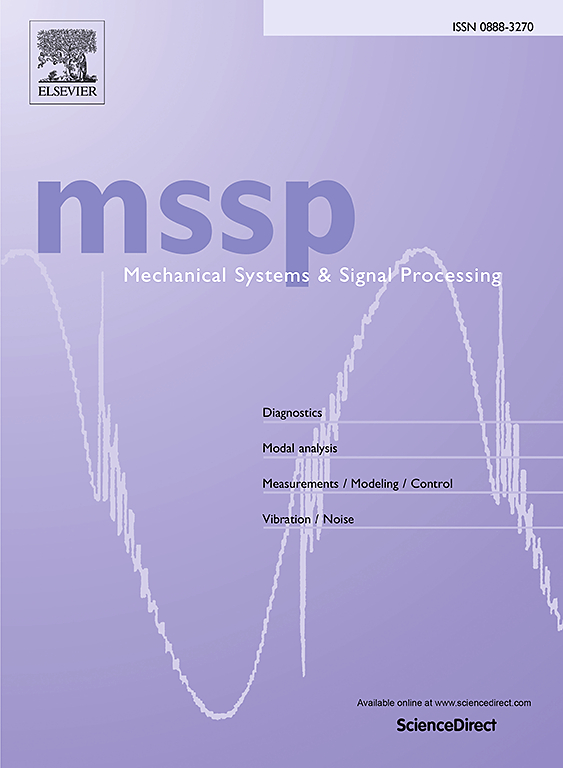A ‘multiple modes’ − ‘multiple parameters’ sensing methodology: Part I – Theoretical modelling
IF 7.9
1区 工程技术
Q1 ENGINEERING, MECHANICAL
引用次数: 0
Abstract
This paper, the first of two companion papers, reports a sensing methodology for synchronous and successive detection of ‘multiple parameters’, via ‘multiple modes’ internal resonance in coupled oscillators.
Detection of ‘multiple parameters’ such as mass, force and damping, characterizing different kinds of perturbations such as weak forces, weak physical fields, trace pollutants or toxic, explosive substances and biological viruses, is crucial for nanotechnology, quantum computer, chemical production, public health and safety etc. with high engineering value.
However, quantitative detection of ‘multiple parameters’ is challenged by too many modes (i.e. more than three ones), intermittent detection, inevitable decoupling, as well as conditional parameter ratio in reported art works.
A ‘multiple modes’ − ‘multiple parameters’ sensing methodology, driven by ‘multiple modes’ internal resonance and supported by two theoretical models, is therefore proposed to address the above challenges with coupled oscillators.
The first theoretical model is established for ‘multiple modes’ internal resonance with 1:3 frequency ratios, while the second one is comprised of two nonlinear sensing theories with and without decoupling respectively, established for synchronous and successive detection of ‘multiple parameters’.
The proposed sensing methodology is physically universal and applicable to parameters, such as mass, force or damping, if convertible to or equivalent to any changes in vibrational coefficients of the oscillator.
The above theoretical models are generalized to different types of vibrational modes, such as flexural, shearing and torsional ones owing to their common characteristic in the higher order mode shapes.
While an experimental validation of the proposed sensing methodology will be discussed in part II.
“多模式”-“多参数”传感方法:第一部分-理论建模
本文是两篇同伴论文中的第一篇,报告了一种通过耦合振荡器中的“多模式”内部共振同步和连续检测“多参数”的传感方法。检测质量、力和阻尼等“多参数”,表征弱力、弱物理场、微量污染物或有毒、爆炸性物质和生物病毒等不同类型的扰动,对于纳米技术、量子计算机、化学生产、公共卫生和安全等具有很高的工程价值。然而,对“多参数”的定量检测存在模式过多(即超过三种)、间歇性检测、不可避免的解耦以及所报道的艺术作品中的条件参数比等问题。因此,提出了一种由“多模式”内部共振驱动并由两个理论模型支持的“多模式”-“多参数”传感方法,以解决耦合振荡器的上述挑战。第一个理论模型是针对频率比为1:3的“多模态”内共振建立的,第二个理论模型是由两种非线性传感理论组成,分别用于“多参数”的同步和连续检测。提出的传感方法在物理上是通用的,适用于参数,如质量,力或阻尼,如果可以转换为或相当于振荡器振动系数的任何变化。由于上述理论模型具有较高阶振型的共同特征,因此可以推广到弯曲、剪切和扭转等不同类型的振动模态。而实验验证提出的传感方法将在第二部分进行讨论。
本文章由计算机程序翻译,如有差异,请以英文原文为准。
求助全文
约1分钟内获得全文
求助全文
来源期刊

Mechanical Systems and Signal Processing
工程技术-工程:机械
CiteScore
14.80
自引率
13.10%
发文量
1183
审稿时长
5.4 months
期刊介绍:
Journal Name: Mechanical Systems and Signal Processing (MSSP)
Interdisciplinary Focus:
Mechanical, Aerospace, and Civil Engineering
Purpose:Reporting scientific advancements of the highest quality
Arising from new techniques in sensing, instrumentation, signal processing, modelling, and control of dynamic systems
 求助内容:
求助内容: 应助结果提醒方式:
应助结果提醒方式:


